简爱作者简介-英文
简爱英文简介10篇
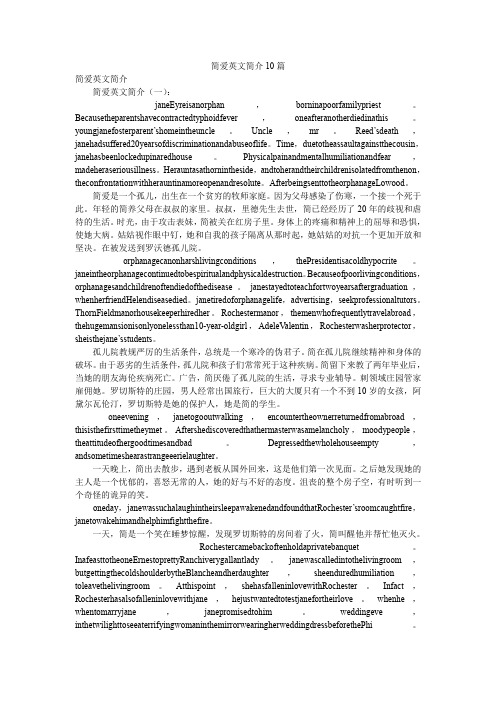
简爱英文简介10篇简爱英文简介简爱英文简介(一):janeEyreisanorphan,borninapoorfamilypriest。
Becausetheparentshavecontractedtyphoidfever,oneafteranotherdiedinathis。
youngjanefosterparent’shomeintheuncle。
Uncle,mr。
Reed’sdeath,janehadsuffered20yearsofdiscriminationandabuseoflife。
Time,duetotheassaultagainstthecousin,janehasbeenlockedupinaredhouse。
Physicalpainandmentalhumiliationandfear,madeheraseriousillness。
Herauntasathornintheside,andtoherandtheirchildrenisolatedfromthenon,theconfrontationwithherauntinamoreopenandresolute。
AfterbeingsenttotheorphanageLowood。
简爱是一个孤儿,出生在一个贫穷的牧师家庭。
因为父母感染了伤寒,一个接一个死于此。
年轻的简养父母在叔叔的家里。
叔叔,里德先生去世,简已经经历了20年的歧视和虐待的生活。
时光,由于攻击表妹,简被关在红房子里。
身体上的疼痛和精神上的屈辱和恐惧,使她大病。
姑姑视作眼中钉,她和自我的孩子隔离从那时起,她姑姑的对抗一个更加开放和坚决。
在被发送到罗沃德孤儿院。
orphanagecanonharshlivingconditions,thePresidentisacoldhypocrite。
janeintheorphanagecontinuedtobespiritualandphysicaldestruction。
简爱介绍——英文

简介:
Jane Eyre: Written by C Bronte Introduction and Notes by Dr Sally Minogue, Canterbury Christ Church University College. Jane Eyre ranks as one of the greatest and most perennially popular works of English fiction. Although the poor but plucky heroine is outwardly of plain appearance, she possesses an indomitable spirit, a sharp wit and great courage. She is forced to battle against the exigencies of a cruel guardian, a harsh employer and a rigid social order. All of which circumscribe her life and position when she becomes governess to the daughter of the mysterious, sardonic and attractive Mr Rochester. However, there is great kindness and warmth in this epic love story, which is set against the magnificent backdrop of the Yorkshire moors.
• Tutor
Jane Eyre 简爱中英文双语介绍
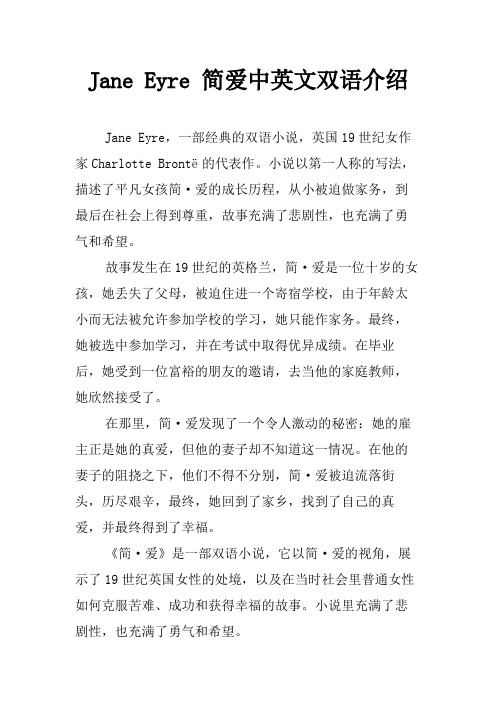
Jane Eyre 简爱中英文双语介绍Jane Eyre,一部经典的双语小说,英国19世纪女作家Charlotte Brontë的代表作。
小说以第一人称的写法,描述了平凡女孩简·爱的成长历程,从小被迫做家务,到最后在社会上得到尊重,故事充满了悲剧性,也充满了勇气和希望。
故事发生在19世纪的英格兰,简·爱是一位十岁的女孩,她丢失了父母,被迫住进一个寄宿学校,由于年龄太小而无法被允许参加学校的学习,她只能作家务。
最终,她被选中参加学习,并在考试中取得优异成绩。
在毕业后,她受到一位富裕的朋友的邀请,去当他的家庭教师,她欣然接受了。
在那里,简·爱发现了一个令人激动的秘密:她的雇主正是她的真爱,但他的妻子却不知道这一情况。
在他的妻子的阻挠之下,他们不得不分别,简·爱被迫流落街头,历尽艰辛,最终,她回到了家乡,找到了自己的真爱,并最终得到了幸福。
《简·爱》是一部双语小说,它以简·爱的视角,展示了19世纪英国女性的处境,以及在当时社会里普通女性如何克服苦难、成功和获得幸福的故事。
小说里充满了悲剧性,也充满了勇气和希望。
Jane Eyre is a classic bilingual novel by English female writer Charlotte Brontë in the 19th century. The novel is written in first-person narrative, depicting the growing journey ofordinary girl Jane Eyre, from being forced to do housework to finally getting respect in society. The story is full of tragedy, but also courage and hope.The story takes place in England in the 19th century. Jane Eyre was a 10-year-old girl who had lost her parents and was forced to stay in a boarding school. Because she was too young to be allowed to study in the school, she could only do housework. Finally, she was chosen to attend classes and achieved excellent results in the exam. After graduation, she was invited by a wealthy friend to be his family teacher, and she acceptedit happily.There, Jane Eyre discovered an exciting secret: her employer was her true love, but his wife didn't know about it. Faced with his wife's obstruction, they had to separate. Jane Eyre was forced towander the streets and endure hardships. Finally, she returned home and found her true love and eventually got happiness.Jane Eyre is a bilingual novel that shows the plight of women in 19th century England and how ordinary women overcame difficulties, succeeded, and gained happiness in the society at that time through Jane Eyre's perspective. The novel is full of tragedy, but also courage and hope.。
简爱简介

简爱简介《简爱》(Jane Eyre)是十九世纪英国著名的女作家夏洛蒂勃朗特的代表作,人们普遍认为《简爱》是夏洛蒂勃朗特诗意的生平写照,是一部具有自传色彩的作品。
下面是为你带来的简爱简介,欢迎阅读。
这本小说是一部具有浓厚浪漫主义色彩的现实主义小说。
作者用优雅细腻的文笔描写了简爱与罗切斯特的爱情。
主人公简爱是一个心地纯洁、善于思考的女性,她生活在社会底层,受尽磨难。
但是她有倔强的性格和勇于追求平等幸福的精神。
小说以浓郁抒情的笔法和深刻细腻的心理描写,引人入胜地展示了男女主人公曲折起伏的爱情经历,歌颂了摆脱一切旧习俗和偏见。
扎根于相互理解、相互尊重的基础之上的深挚爱情,具有强烈的震撼心灵的艺术力量。
其最为成功之处在于塑造了一个敢于反抗,敢于争取自由和平等地位的妇女形象 [3]。
简爱是个孤女,她出生于一个穷牧师家庭。
父母由于染上了伤寒病,在一个月之中相继去世。
年幼的简寄养在舅父母家里。
舅父里德先生在红房子中去世后,简爱过了10年倍受尽歧视和虐待的生活。
一次,由于反抗表哥的殴打,简被关进了红房子。
肉体上的痛苦和心灵上的屈辱与恐惧,使她大病了一场。
舅母把她视作眼中钉,并把她和自己的孩子隔离开来,从此,她与舅母的对抗更加公开和坚决了。
此后,简被送进了罗沃德孤儿院。
孤儿院教规严厉,生活艰苦,院长是个冷酷的伪君子。
简在孤儿院继续受到精神和肉体上的摧残。
由于恶劣的生活条件,孤儿院经常有孩子病死,她最好的朋友海伦在一次大的斑疹伤寒中去世了。
这次斑疹伤寒的病逝人数引起了人们的注意,找到了发病的原因,这使孤儿院有了很大的改善。
简在新的环境下接受了六年的教育,并在这所学校任教两年。
由于坦普尔小姐的离开,简厌倦了孤儿院里的生活,登广告谋求家庭教师的职业。
桑菲尔德庄园的女管家聘用了她。
庄园的男主人罗切斯特经常在外旅行,偌大的宅邸只有一个不到10岁的女孩阿黛拉瓦朗,罗切斯特是她的保护人,她就是简的学生。
一天黄昏,简外出散步,邂逅刚从国外归来的主人,这是他们第一次见面。
Jane Eyre 简爱中英文双语介绍
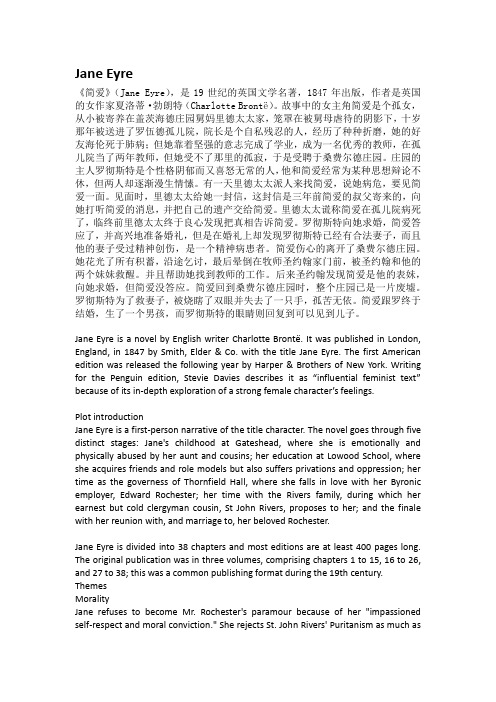
Jane Eyre《简爱》(Jane Eyre),是19世纪的英国文学名著,1847年出版,作者是英国的女作家夏洛蒂·勃朗特(Charlotte Brontë)。
故事中的女主角简爱是个孤女,从小被寄养在盖茨海德庄园舅妈里德太太家,笼罩在被舅母虐待的阴影下,十岁那年被送进了罗伍德孤儿院,院长是个自私残忍的人,经历了种种折磨,她的好友海伦死于肺病;但她靠着坚强的意志完成了学业,成为一名优秀的教师,在孤儿院当了两年教师,但她受不了那里的孤寂,于是受聘于桑费尔德庄园。
庄园的主人罗彻斯特是个性格阴郁而又喜怒无常的人,他和简爱经常为某种思想辩论不休,但两人却逐渐漫生情愫。
有一天里德太太派人来找简爱,说她病危,要见简爱一面。
见面时,里德太太给她一封信,这封信是三年前简爱的叔父寄来的,向她打听简爱的消息,并把自己的遗产交给简爱。
里德太太谎称简爱在孤儿院病死了,临终前里德太太终于良心发现把真相告诉简爱。
罗彻斯特向她求婚,简爱答应了,并高兴地准备婚礼,但是在婚礼上却发现罗彻斯特已经有合法妻子,而且他的妻子受过精神创伤,是一个精神病患者。
简爱伤心的离开了桑费尔德庄园。
她花光了所有积蓄,沿途乞讨,最后晕倒在牧师圣约翰家门前,被圣约翰和他的两个妹妹救醒。
并且帮助她找到教师的工作。
后来圣约翰发现简爱是他的表妹,向她求婚,但简爱没答应。
简爱回到桑费尔德庄园时,整个庄园已是一片废墟。
罗彻斯特为了救妻子,被烧瞎了双眼并失去了一只手,孤苦无依。
简爱跟罗终于结婚,生了一个男孩,而罗彻斯特的眼睛则回复到可以见到儿子。
Jane Eyre is a novel by English writer Charlotte Brontë. It was published in London, England, in 1847 by Smith, Elder & Co. with the title Jane Eyre. The first American edition was released the following year by Harper & Brothers of New York. Writing for the Penguin edition, Stevie Davies describes it as “influential feminist text” because of its in-depth exploration of a strong female character’s feelings.Plot introductionJane Eyre is a first-person narrative of the title character. The novel goes through five distinct stages: Jane's childhood at Gateshead, where she is emotionally and physically abused by her aunt and cousins; her education at Lowood School, where she acquires friends and role models but also suffers privations and oppression; her time as the governess of Thornfield Hall, where she falls in love with her Byronic employer, Edward Rochester; her time with the Rivers family, during which her earnest but cold clergyman cousin, St John Rivers, proposes to her; and the finale with her reunion with, and marriage to, her beloved Rochester.Jane Eyre is divided into 38 chapters and most editions are at least 400 pages long. The original publication was in three volumes, comprising chapters 1 to 15, 16 to 26, and 27 to 38; this was a common publishing format during the 19th century. ThemesMoralityJane refuses to become Mr. Rochester's paramour because of her "impassioned self-respect and moral conviction." She rejects St. John Rivers' Puritanism as much asthe libertine aspects of Mr. Rochester's character. Instead, she works out a morality expressed in love, independence, and forgiveness. Jane does not want to be seen as an outcast to society by being a mistress to Rochester.FeminismThe role and standing of women in the Victorian era is considered by Brontë in Jane Eyre, specifically in regard to Jane's independence and ability to make decisions for herself. As a young woman, small and of relatively low social standing, Jane encounters men during her journey, of good, bad, and morally debatable character. However, many of them, no matter their ultimate intentions, attempt to establish some form of power and control over Jane. One example can be seen in Mr. Rochester, a man who ardently loves Jane, but who frequently commands and orders Jane about. As a self-assured and established man, and her employer, Mr. Rochester naturally assumes the position of the master in their relationship. He sometimes demands rather than questioning Jane, tries to manipulate and assess her feelings towards him, and enjoys propping up Jane through excessive gifts and luxuries that only he would have been able to provide. Jane, however, believes in the importance of women's independence, and strives to maintain a position in life devoid of any debts to others. Her initial lack of money and social status unnerves her, as she realizes that without the means to be an independent woman, she is bound to either struggle through life trying to make a living or marry and become dependent on a man. Even after Jane agrees to marry Mr. Rochester, and is swept up in the passion of the moment, the feminist elements of her personality still show through. She is uncomfortable with the showering of lavish gifts, as she resents that they will make her further reliant on and in debt to Mr. Rochester, and thus tries to resist them. Furthermore, Jane asserts that even after she is married to Mr. Rochester, she will continue to be Adèle's governess and earn her keep. This plan, which was entirely radical and unheard of for the time, further illustrates Jane's drive to remain a somewhat independent woman. While the significant men present in Jane's life throughout the novel all try to, in some form or another, establish themselves as dominant over Jane, she in most cases remains resistant at least to a certain degree, refusing to submit fully or lose all of her independence.。
Jane Eyre简爱英文版
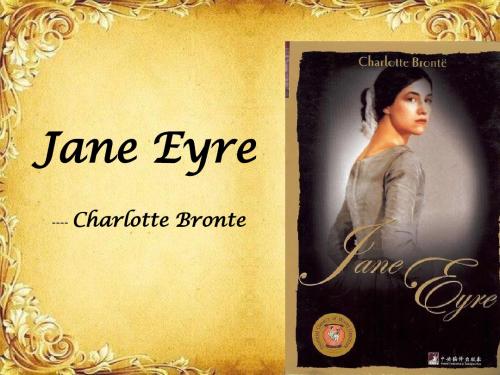
My View
Jane’s life was sympathetic and hard, but her strong mind to pursue equal and independent impressed me deeply. Jane thought that love was based on the spiritual equality, and only loved each other can couple obtained happiness. So Jane didn’t give up her love because of the social status. Rochester was in the upper class, but he had fed up with the sham of it. It was Jane's kind and strong mind that woke him up just like a fresh wind.
Jane's story makes me thinking about my life and I learned much from her experience. We should have a strong mind, be tolerate and have confidence and courage to confront with difficulties and troubles.
However, when they held the wedding,
Bertha’s brother turned up and stopped them, for Rochester had a wife living. Though Jane loved her master with great affection, she decided to leave him. After suffering a lot in her leaving way, she met her cousin, Brocklehurst, and inherited a large number of legacies. When he promised to Jane Eyre, she thought of Mr. Rochester and finally returned. After finding Rochester’s misfortune brought by his original mad wife, Jane chose to stay with him forever.
《简爱》 英文简介
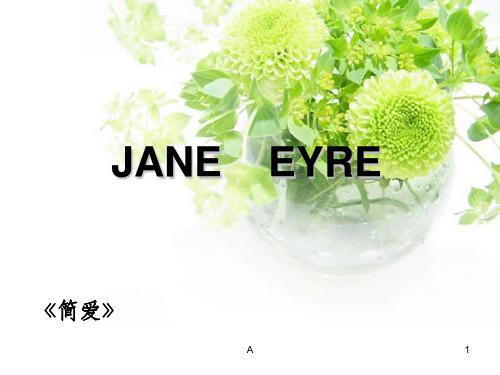
A
3
The heroine
• Jane Eyre - the heroine, a strong personality, simple, independent and aggressive women. Her contempt for the arrogance of the rich and powerful, and laugh at their stupid show the personality and beautiful ideals of self-reliance. She has great vitality, never bow to fate. Have their own longing for a better life.
A
5
• 简爱是个可怜的牧师的女儿,当她还是个孩子的时候,她 的父母去世了。她的舅妈里德太太不喜欢她。当她叔叔死 后她被送到孤儿院。
• 简从学校毕业后,她作为一个教师去了桑菲尔德(罗切斯 特先生的庄园)。在多次接触后,她爱上了罗切斯特。
• 但当他们结婚的那天 ,简意外地知道罗切斯特的前妻并 没有死,他的疯妻被关在庄园中。所以简离开了,之后她 偶然地遇见她的表哥表姐 。
• But when the day they got married , Jane knew Rochester's ex-wife didn’t die by accident, and his exwife was crazy and was shut in the manor. so Jane left and met his cousin cousin occasionally .
简爱英文简介

简爱英文简介简爱英文简介简爱英文简介(一):Jane Eyre is an orphan,born in a poor family priest。
Because the parents have contracted typhoid fever, one after another died in a this。
Young Jane foster parent's home in the uncle。
Uncle, Mr。
Reed's death, Jane had suffered 20 years of discrimination and abuse of life。
Time, due to the assault against the cousin, Jane has been locked up in a red house。
Physical pain and mental humiliation and fear,made her a serious illness。
Her aunt as a thorn in the side, and to her and their children isolated from then on, the confrontation with her aunt in a more open and resolute。
After being sent to the orphanage Lowood。
简爱是一个孤儿,出生在一个贫穷的牧师家庭。
因为父母感染了伤寒,一个接一个死于此。
年轻的简养父母在叔叔的家里。
叔叔,里德先生去世,简已经经历了20年的歧视和虐待的生活。
时光,由于攻击表妹,简被关在红房子里。
身体上的疼痛和精神上的屈辱和恐惧,使她大病。
姑姑视作眼中钉,她和自我的孩子隔离从那时起,她姑姑的对抗一个更加开放和坚决。
在被发送到罗沃德孤儿院。
《简爱》名著简介
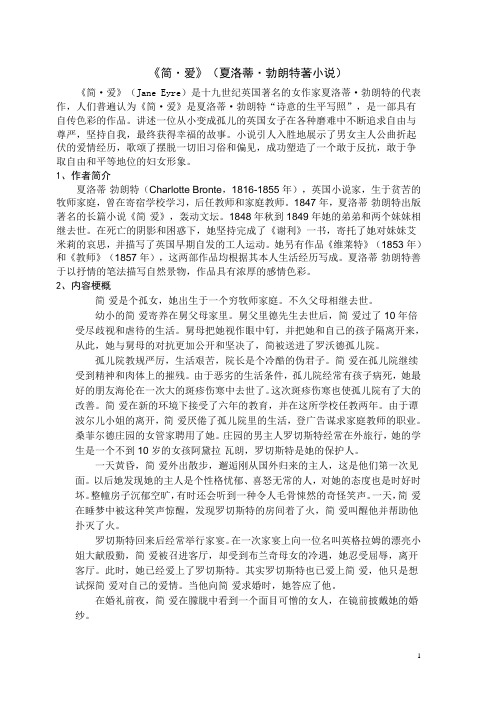
《简·爱》(夏洛蒂·勃朗特著小说)《简·爱》(Jane Eyre)是十九世纪英国著名的女作家夏洛蒂·勃朗特的代表作,人们普遍认为《简·爱》是夏洛蒂·勃朗特“诗意的生平写照”,是一部具有自传色彩的作品。
讲述一位从小变成孤儿的英国女子在各种磨难中不断追求自由与尊严,坚持自我,最终获得幸福的故事。
小说引人入胜地展示了男女主人公曲折起伏的爱情经历,歌颂了摆脱一切旧习俗和偏见,成功塑造了一个敢于反抗,敢于争取自由和平等地位的妇女形象。
1、作者简介夏洛蒂·勃朗特(Charlotte Bronte,1816-1855年),英国小说家,生于贫苦的牧师家庭,曾在寄宿学校学习,后任教师和家庭教师。
1847年,夏洛蒂·勃朗特出版著名的长篇小说《简·爱》,轰动文坛。
1848年秋到1849年她的弟弟和两个妹妹相继去世。
在死亡的阴影和困惑下,她坚持完成了《谢利》一书,寄托了她对妹妹艾米莉的哀思,并描写了英国早期自发的工人运动。
她另有作品《维莱特》(1853年)和《教师》(1857年),这两部作品均根据其本人生活经历写成。
夏洛蒂·勃朗特善于以抒情的笔法描写自然景物,作品具有浓厚的感情色彩。
2、内容梗概简·爱是个孤女,她出生于一个穷牧师家庭。
不久父母相继去世。
幼小的简·爱寄养在舅父母家里。
舅父里德先生去世后,简·爱过了10年倍受尽歧视和虐待的生活。
舅母把她视作眼中钉,并把她和自己的孩子隔离开来,从此,她与舅母的对抗更加公开和坚决了,简被送进了罗沃德孤儿院。
孤儿院教规严厉,生活艰苦,院长是个冷酷的伪君子。
简·爱在孤儿院继续受到精神和肉体上的摧残。
由于恶劣的生活条件,孤儿院经常有孩子病死,她最好的朋友海伦在一次大的斑疹伤寒中去世了。
这次斑疹伤寒也使孤儿院有了大的改善。
简·爱在新的环境下接受了六年的教育,并在这所学校任教两年。
小说《简爱》的英文简介

《简爱》是英国小说阿基夏洛蒂•勃朗特的作品,刻画了一个女性的成长历程。
就让我们一起重温这部经典,来看看《简爱》的英文简介。
Jane Eyre is a novel by English writer Charlotte Brontë. It was published in London, England, in 1847 with the title Jane Eyre. An Autobiography under the pen name "Currer Bell". The Penguin edition describes it as an "influential feminist text" because of its in-depth exploration of a strong female character's feelings.《简爱》是英国小说作家夏洛蒂•勃朗特的作品,1847年在英国伦敦出版,书名定为自传《简爱》,以笔名“库瑞尔•贝尔”署名。
Penguin出版社的版次将小说誉为“具有影响力的女权主义文本”,因为小说深入探索了女主角的强烈情感。
The novel merges elements of three distinct genres. It has the form of a Bildungsroman, a story about a child's maturation, focusing on the emotions and experiences that accompany growth to adulthood. The novel also contains much social criticism, with a strong sense of morality at its core, and finally has the brooding and moody quality and Byronic character typical of Gothic fiction. 小说融合了三截然不同的写作风格。
【精编范文】简爱作者简介-范文word版 (6页)

本文部分内容来自网络整理,本司不为其真实性负责,如有异议或侵权请及时联系,本司将立即删除!== 本文为word格式,下载后可方便编辑和修改! ==简爱作者简介篇一:简爱作者简介Charlotte Bronte was born in the north of England in a priest family, in1816. Her mother died, at the age of eight, Charlotte was sent to aboarding school where living conditions were extremely poor, due toher two sisters have died. Charlotte and her sister Emily returned home,in the desolate mountains spent her childhood. At the age of fifteen,Charlotte go to school, a few years later as a teacher in this school.She also worked as a tutor, eventually because of cannot bear thetutor's discrimination and mistreatment, she resigned. She hadintended to run a school. However due to the lack of students, theschool did not run. But learning experiences in Italy inspired Charlotte'sstrong desire to express them. In 1846, she completed her secondnovel" Jane Eyre ". In the autumn of 1847 the novel published, withgreat success, reprinted two times next year, let the unknown authorbecome one of the famous British novelists.夏洛蒂·勃朗特,1816年,夏洛蒂·勃朗特出生于英国北部的一个牧师家庭。
夏洛蒂勃朗特的简介
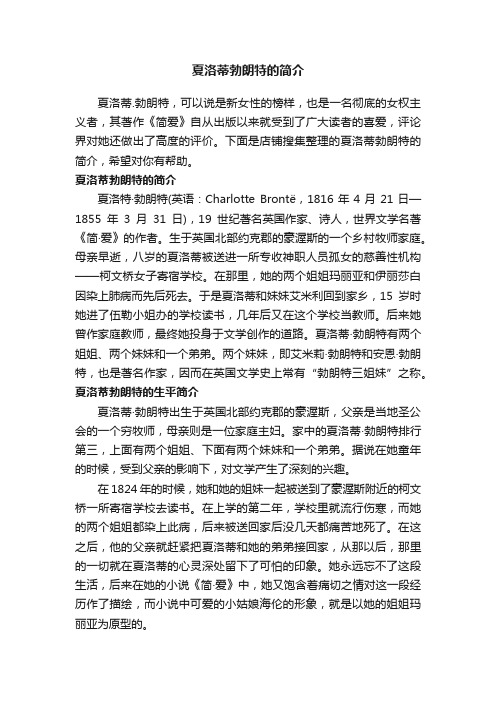
夏洛蒂勃朗特的简介夏洛蒂.勃朗特,可以说是新女性的榜样,也是一名彻底的女权主义者,其著作《简爱》自从出版以来就受到了广大读者的喜爱,评论界对她还做出了高度的评价。
下面是店铺搜集整理的夏洛蒂勃朗特的简介,希望对你有帮助。
夏洛蒂勃朗特的简介夏洛特·勃朗特(英语:Charlotte Brontë,1816年4月21日—1855年3月31日),19世纪著名英国作家、诗人,世界文学名著《简·爱》的作者。
生于英国北部约克郡的豪渥斯的一个乡村牧师家庭。
母亲早逝,八岁的夏洛蒂被送进一所专收神职人员孤女的慈善性机构——柯文桥女子寄宿学校。
在那里,她的两个姐姐玛丽亚和伊丽莎白因染上肺病而先后死去。
于是夏洛蒂和妹妹艾米利回到家乡,15岁时她进了伍勒小姐办的学校读书,几年后又在这个学校当教师。
后来她曾作家庭教师,最终她投身于文学创作的道路。
夏洛蒂·勃朗特有两个姐姐、两个妹妹和一个弟弟。
两个妹妹,即艾米莉·勃朗特和安恩·勃朗特,也是著名作家,因而在英国文学史上常有“勃朗特三姐妹”之称。
夏洛蒂勃朗特的生平简介夏洛蒂·勃朗特出生于英国北部约克郡的豪渥斯,父亲是当地圣公会的一个穷牧师,母亲则是一位家庭主妇。
家中的夏洛蒂·勃朗特排行第三,上面有两个姐姐、下面有两个妹妹和一个弟弟。
据说在她童年的时候,受到父亲的影响下,对文学产生了深刻的兴趣。
在1824年的时候,她和她的姐妹一起被送到了豪渥斯附近的柯文桥一所寄宿学校去读书。
在上学的第二年,学校里就流行伤寒,而她的两个姐姐都染上此病,后来被送回家后没几天都痛苦地死了。
在这之后,他的父亲就赶紧把夏洛蒂和她的弟弟接回家,从那以后,那里的一切就在夏洛蒂的心灵深处留下了可怕的印象。
她永远忘不了这段生活,后来在她的小说《简·爱》中,她又饱含着痛切之情对这一段经历作了描绘,而小说中可爱的小姑娘海伦的形象,就是以她的姐姐玛丽亚为原型的。
简爱小说简介
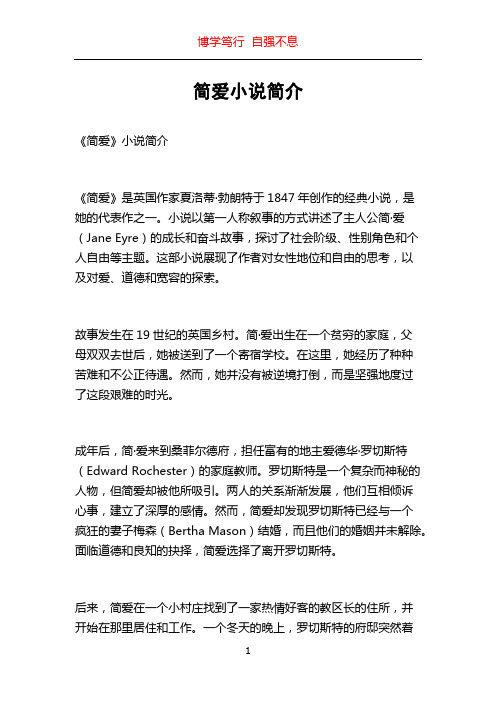
简爱小说简介《简爱》小说简介《简爱》是英国作家夏洛蒂·勃朗特于1847年创作的经典小说,是她的代表作之一。
小说以第一人称叙事的方式讲述了主人公简·爱(Jane Eyre)的成长和奋斗故事,探讨了社会阶级、性别角色和个人自由等主题。
这部小说展现了作者对女性地位和自由的思考,以及对爱、道德和宽容的探索。
故事发生在19世纪的英国乡村。
简·爱出生在一个贫穷的家庭,父母双双去世后,她被送到了一个寄宿学校。
在这里,她经历了种种苦难和不公正待遇。
然而,她并没有被逆境打倒,而是坚强地度过了这段艰难的时光。
成年后,简·爱来到桑菲尔德府,担任富有的地主爱德华·罗切斯特(Edward Rochester)的家庭教师。
罗切斯特是一个复杂而神秘的人物,但简爱却被他所吸引。
两人的关系渐渐发展,他们互相倾诉心事,建立了深厚的感情。
然而,简爱却发现罗切斯特已经与一个疯狂的妻子梅森(Bertha Mason)结婚,而且他们的婚姻并未解除。
面临道德和良知的抉择,简爱选择了离开罗切斯特。
后来,简爱在一个小村庄找到了一家热情好客的教区长的住所,并开始在那里居住和工作。
一个冬天的晚上,罗切斯特的府邸突然着火了。
简爱得知这个消息后立即返回,而在废墟中她发现了一个失去手脚行动不便的罗切斯特,他和他的妻子在火灾中受到了重伤。
此刻,简爱决定留在罗切斯特身边,承诺与他一同度过余生。
《简爱》以其深入探讨心理和情感的描写,揭示了19世纪英国社会中阶级和性别的斗争。
小说主角简爱的形象深受读者喜爱,她是一个聪明、独立、勇敢的女性,能够克服各种困难和压力,在艰难的生活中追求自由和幸福。
此外,小说中的罗切斯特也是一个备受争议的角色。
他从一开始就让人感到神秘和吸引,但他的婚姻问题引发了伦理和道德的争议。
作者通过这个角色刻画了19世纪男性对权力和欲望的追求,以及女性如何应对这些挑战。
尽管《简爱》是一部19世纪的小说,但它的主题和情感仍然具有现代意义。
简爱知识点整理及归纳考点
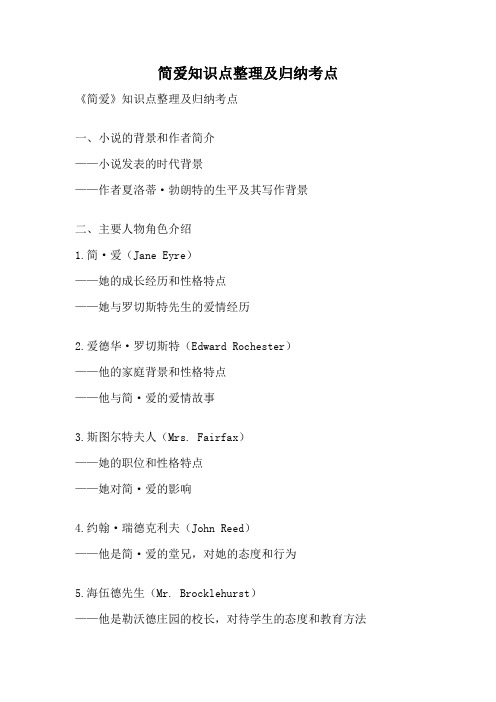
简爱知识点整理及归纳考点《简爱》知识点整理及归纳考点一、小说的背景和作者简介——小说发表的时代背景——作者夏洛蒂·勃朗特的生平及其写作背景二、主要人物角色介绍1.简·爱(Jane Eyre)——她的成长经历和性格特点——她与罗切斯特先生的爱情经历2.爱德华·罗切斯特(Edward Rochester)——他的家庭背景和性格特点——他与简·爱的爱情故事3.斯图尔特夫人(Mrs. Fairfax)——她的职位和性格特点——她对简·爱的影响4.约翰·瑞德克利夫(John Reed)——他是简·爱的堂兄,对她的态度和行为5.海伍德先生(Mr. Brocklehurst)——他是勒沃德庄园的校长,对待学生的态度和教育方法6.黛安娜和玛丽(Diana and Mary Rivers)——她们是简·爱的表妹,对她的帮助和支持三、小说的主要情节1.简·爱的童年和成长经历——她在叔叔家的遭遇和离开——她进入勒沃德庄园学校的经历2.简·爱的职业生涯和成就——她成为杰特沃德庄园的家庭教师——她离开庄园后的工作经历3.简·爱与罗切斯特先生的相识和爱情发展——她在杰特沃德庄园与罗切斯特先生的初次相遇——她与罗切斯特先生的爱情经历和困难4.罗切斯特先生的家庭秘密和结局——罗切斯特先生的婚姻史和妻子贝拉——简·爱与罗切斯特先生的困境和最终结局四、小说的主题和意义1.女性地位和自由意志的探讨——小说中女性角色的命运和选择——女性独立和追求幸福的意义2.爱情与自我价值的平衡——简·爱对待爱情和自我价值的态度——爱情对于个体的影响和塑造3.社会阶级和道德观念的冲突——罗切斯特先生的身份和财富对爱情的影响——小说对社会阶级观念的批判五、小说的文学特点和艺术手法1.第一人称叙事和情感描写——小说以简·爱的视角叙述,增强了情感共鸣——作者通过详细的描写营造出真实的情感氛围2.对内心世界的揭示和探索——小说通过人物的内心独白展现情感和思想变化——通过对内心的描写,深入探讨人性和情感的复杂性3.对社会现实的关注和批判——小说对当时英国社会的不公和阶级固化进行了揭示——通过人物的命运展现社会问题和不平等现象六、小说的影响与评价1.《简爱》在当时的影响和争议——小说引起了社会和文学界的广泛关注——对女性地位和自由意志的探讨具有重要意义2.《简爱》的文学价值和地位——小说成为英国文学的经典之作——作者勃朗特对情感和人性的深刻描写备受赞誉3.读者对《简爱》的感受和评价——读者对小说中人物的喜爱和关注——小说中的爱情故事对读者产生的共鸣和影响总结:《简爱》是一部具有深刻人性描写和社会批判的经典小说。
Jane Eyre 小说简爱的英文介绍
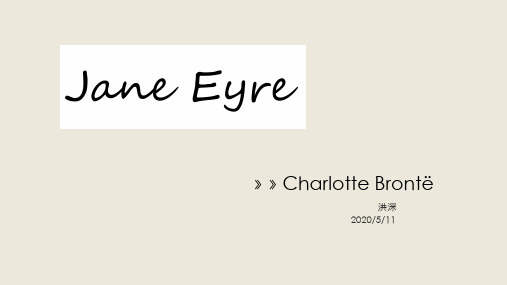
Introduction of the book
Jane Eyre is a special image out of ordinary. She makes a life by herself, dares to express her own idea. Uder the pressure of life, she always maintains her self-respect by hard work,intelligence and her tough individualism. She never gives in her own way. Though she has little figure, Jane Eyre is huge in soul. She pursues true love and is loyal and steadfast to her beloved man. Her kindness,intelligence, and independence attract the hero. At las,tshe gets a perfect love.
Early life and education
In August 1824 Patrick Brontë sent Charlotte, Emily, Maria and Elizabeth to the Clergy Daughters' School. Charlotte maintained that the school's poor conditions permanently affected her health and physical development, and hastened the deaths of Maria and Elizabeth , who both died of tuberculosis(肺结核) In June 1825.After the deaths of her older sisters her father removed Charlotte and Emily from the school. Charlotte used the school as the basis for Lowood School in Jane Eyre.
Jane Eyre 简爱英文简介

Person's Value=Dignity+Love
My views Jane Eyre is very much the story of quest to be loved.Jane searches,not just for romantic love,but aslo for a sense of being valued. She is poor in her living condition,but she is huge in soul.We still remember her goodness, self-respect and the braveness to pursuit equality. In my mind,though a person's beauty on face can make others once feel that one is attractive and charming,but if his or her mind isn't the same beautiful as the appearance,the beauty cannot last for long time .For a long time,only a person's great virtue,a noble soul, a beautiful heart can be called as long lasting beauty.
Thank you!
First meet
Thornfield
- 1、下载文档前请自行甄别文档内容的完整性,平台不提供额外的编辑、内容补充、找答案等附加服务。
- 2、"仅部分预览"的文档,不可在线预览部分如存在完整性等问题,可反馈申请退款(可完整预览的文档不适用该条件!)。
- 3、如文档侵犯您的权益,请联系客服反馈,我们会尽快为您处理(人工客服工作时间:9:00-18:30)。
Charlotte Brontë (April 21, 1816 – March 31, 1855) was an English novelist, the eldest of the three Brontë sisters whose novels have become enduring classics of English literature. Life and worksCharlotte Brontë was born at Thornton, in Yorkshire, England, the third of six children, to Patrick Brontë (formerly "Patrick Brunty"), an Irish Anglican clergyman, and his wife, Maria Branwell. In April 1820 the family moved to Haworth, where Patrick had been appointed Perpetual Curate. Maria Branwell Brontë died of cancer on 15 September 1821, leaving five daughters and a son to the care of her sister Elizabeth Branwell. In August 1824, Charlotte was sent with three of her sisters to the Clergy Daughters' School at Cowan Bridge in Lancashire (which she would describe as Lowood School in Jane Eyre). Its poor conditions, Charlotte maintained, permanently affected her health and physical development, and hastened the deaths of her two elder sisters, Maria (born 1814) and Elizabeth (born 1815), who died of tuberculosis in 1825 soon after they were removed from the school. At home in Haworth Parsonage, Charlotte and the other surviving children — Branwell, Emily, and Anne — were influenced by their father's library of Walter Scott, Byron, Tales of the Genii and The Arabian Nights. They began chronicling the lives and struggles of the inhabitants of their imaginary kingdoms. Charlotte and Branwell wrote stories about their country — Angria — and Emily and Anne wrote articles and poems about theirs — Gondal. The sagas were elaborate and convoluted (and still exist in part manuscripts) and provided them with an obsessive interest in childhood and early adolescence, which prepared them for their literary vocations in adulthood. Charlotte continued her education at Roe Head school in Mirfield from 1831 to 1832, where she met her lifelong friends and correspondents, Ellen Nussey and Mary Taylor. Charlotte returned as a teacher from 1835 to 1838. In 1839 she took up the first of many positions as governess to various families in Yorkshire, a career she pursued until 1841. In 1842 she and Emily travelled to Brussels to enroll in a pensionnat run by Constantin Heger (1809–1896) and his wife Claire Zoë Parent Heger (1804–1890). In return for board and tuition, Charlotte taught English and Emily taught music. Their time at the pensionnat was cut short when Elizabeth Branwell, their aunt who joined the family after the death of their mother to look after the children, died of internal obstruction in October 1842. Charlotte returned alone to Brussels in January 1843 to take up a teaching post at the pensionnat. Her second stay at the pensionnat was not a happy one; she became lonely, homesick, and deeply attached to Constantin Heger. She finally returned to Haworth in January 1844 and later used her time at the pensionnat as the inspiration for some of The Professor and Villette. In May 1846, Charlotte, Emily, and Anne published a joint collection of poetry under the assumed names of Currer, Ellis, and Acton Bell. Although the book failed to attract interest (only two copies were sold) the sisters decided to continue writing for publication and began work on their first novels. Charlotte continued to use the name 'Currer Bell' when she published her first two novels. Cover page of the first edition of Jane EyreHer novels are: Jane Eyre, published 1847 Shirley, published 1849 Villette, published 1853 The Professor, written before Jane Eyre and rejected by many publishing houses, was published posthumously in 1857 Her novels were deemed coarse by the critics. Much speculation took place as to who Currer Bell really was, and whether Bell was a man or a woman. Charlotte's brother, Branwell, the only son of the family, died of chronic bronchitis and marasmus exacerbated by heavy drinking, in September 1848, although Charlotte believed his death was due to tuberculosis. Emily and Anne both died of pulmonary tuberculosis in December 1848 and May 1849, respectively. Portrait of Charlotte Brontë, 1873 Charlotte and her father were now left alone. In view of the enormous success of Jane Eyre, she was persuaded by her publisher to visit London occasionally, where she revealed her true identity and began to move in a more exalted social circle, becoming friends with Harriet Martineau, Elizabeth Gaskell, William Makepeace Thackeray and G. H. Lewes. However, she never left Haworth for more than a few weeks at a time as she did not want to leave her aging father's side. In June 1854, Charlotte married Arthur Bell Nicholls, her father's curate.She died nine months later during her first pregnancy. Her death certificate gives the cause of death as phthisis (tuberculosis), but there is a school of thought that suggests she may have died from her excessive vomiting caused by severe morning sickness in the early stages of pregnancy. There is also evidence to suggest that Charlotte died fromtyphus she may have caught from Tabitha Ackroyd, the Bronte household's oldest servant, who died shortly before her. Charlotte was interred in the family vault in The Church of St. Michael and All Angels, Haworth, West Yorkshire, England. The posthumous biography by Elizabeth Gaskell, for a long time a standard source on her life, has been much criticised by feminists such as Elaine Showalter, for suppressing detailsof Charlotte's life and her apparently passionate nature.。
